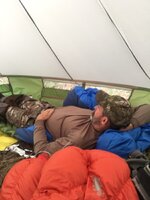optimusprime
WKR
- Joined
- Apr 30, 2015
- Messages
- 449
Who uses a pyramid or single wall tent in wet environments with success? Specifically without a stove. Looking for something like a cimarron or supermid but I keep hearing horror stories about condensation basically wetting them out. Where I hunt there may be very little opportunity to set up in dry areas and rain is usually a given.
Sent from my iPhone using Tapatalk
Sent from my iPhone using Tapatalk

